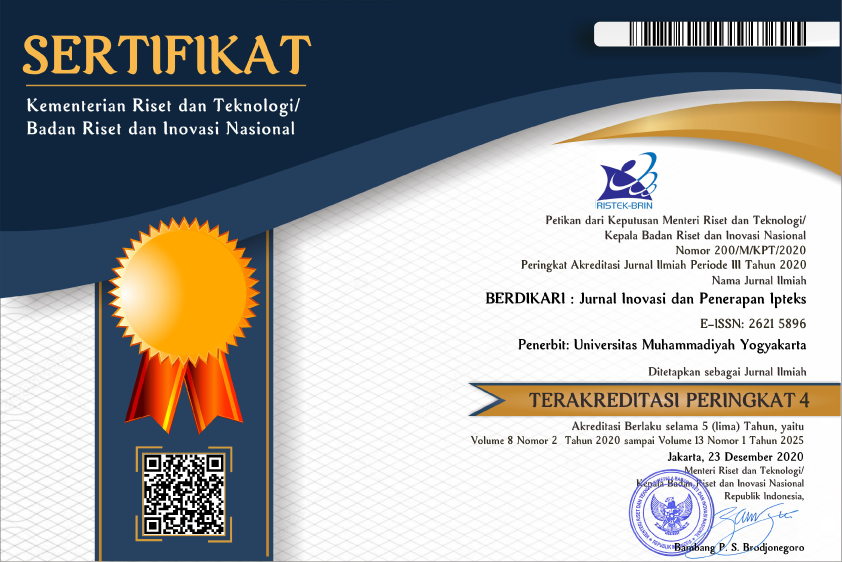Penghitungan Ketenagaan Dengan Metode Workload Indicators Of Staffing Need (WISN) Di RS PKU Muhammadiyah Temanggung
DOI:
https://doi.org/10.18196/bdr.4212Abstract
Penyusunan pola ketenagaan ini merupakan hal krusial dalam kegiatan perencanaan sumber daya manusia di rumah sakit. Banyaknya keluhan dari kepala unit tentang tingginya beban kerja dan kurangnya jumlah tenaga menyebabkan pelayanan kepada pasien kurang optimal. Pelaksanaan pelatihan penghitungan ketenagaan keperawatan dan non medis ini merupakan salah satu cara untuk mencegah terjadinya beban kerja lebih dan meningkatkan kualitas pelayanan rumah sakit. Tujuan pengabdian masyarakat untuk meningkatnya kemampuan kepala unit dalam menyusun pola ketenagaan dan analisis kebutuhan tenaga berdasarkan beban kerja di unit masing masing. Metode yang digunakan dalam pelatihan ini menggunakan metode ceramah, diskusi dan tanya jawab, simulasi, dan praktik. Hasil pelatihan yang telah dilakukan, semua peserta mampu melakukan simulasi penghitungan ketenagaan keperawatan dan non medis. Untuk unit kamar bedah, sudah didapatkan hasil akhir penghitungan jumlah tenaga. Beberapa faktor pendukung keberhasilan pelatihan ini antara lain manajemen RS memberikan dukungan yang sangat tinggi, memberikan fasilitas pelatihan yang sangat baik, peserta memiliki kemauan dan sangat antusias selama pelatihan. Beberapa kendala yang dihadapi selama pelatihan yaitu tidak semua peserta pelatihan membawa laptop sehingga saat simulasi dan praktik para peserta harus bergantian dengan kelompok lain dan arena sebagian besar peserta adalah kepala unit di RS sehingga beberapa diantaranya beberapa kali harus meninggalkan ruang pelatihan karena ada hal penting yang harus diselesaikan di ruangan.
Kata Kunci : WISN, ketenagaan, penghitungan tenaga, perencanaan SDM, pelatihan.
References
Anderson, P. T., Terri. (2010). Medication errors- dont let them happen to you. American Nurse Today, 44(5), 72–72. https://doi.org/10.1097/ 01.NURSE.0000445767.71995.37
Bonfim, D., Laus, A. M., Leal, A. E., Fugulin, F. M. T.,
& Gaidzinski, R. R. (2016). Application of the Workload Indicators of Staffing Need method to predict nursing human resources at a Family Health Service. Revista Latino-Americana de Enfermagem, 24(0). https://doi.org/10.1590/1518-8345.1010.2683
Debergh, D. P., Myny, D., Van Herzeele, I., Van Maele, G., Miranda, D. R., & Colardyn, F. (2012). Measur-ing the nursing workload per shift in the ICU.
Intensive Care Medicine, 38(9), 1438–1444. https://doi.org/10.1007/s00134-012-2648-3 Dubois, C. A., D’amour, D., Tchouaket, E., Clarke, S., Rivard, M., & Blais, R. (2013). Associations of
patient safety outcomes with models of nursing care organization at unit level in hospitals. International Journal for Quality in Health Care, 25(2), 110– 117. https://doi.org/10.1093/intqhc/mzt019
Esmaeili, R., Moosazadeh, M., Alizadeh, M., & Afshari, M. (N.D.). A Systematic Review Of The Workload Of Nurses In Intensive Care Units Using, 6.
Govule, P., Mugisha, J. F., Katongole, S. P., Maniple, E., Nanyingi, M., & Onzima, R. A. D. (n.d.). Application of Workload Indicators of Staffing Needs (WISN) in Determining Health Workers’ Requirements for Mityana General Hospital, Uganda, 10.
Hall, L. H., Johnson, J., Watt, I., Tsipa, A., & O’Connor, D. B. (2016). Healthcare staff wellbeing, burnout, and patient safety: A system-atic review. PLoS ONE, 11(7). https://doi.org/ 10.1371/journal.pone.0159015
Hoi, S. Y., Ismail, N., Ong, L. C., & Kang, J. (2010). Determining nurse staffing needs: the workload intensity measurement system. Journal of Nursing Management, 18(1), 44–53. https://doi.org/ 10.1111/j.1365-2834.2009.01045.x
Mugisha, J. F., & Namaganda, G. (2008). Using The Workload Indicator Of Staffing Needs (WISN) Methodology To Assess Work Pressure.
Downloads
Published
Issue
Section
License
Copyright
Authors retain copyright and grant BERDIKARI Jurnal Inovasi dan Penerapan IPTEK the right of first publication with the work simultaneously licensed under an Attribution 4.0 International (CC BY 4.0) that allows others to remix, adapt and build upon the work with an acknowledgment of the work's authorship and of the initial publication in BERDIKARI Jurnal Inovasi dan Penerapan IPTEK.
Authors are permitted to copy and redistribute the journal's published version of the work (e.g., post it to an institutional repository or publish it in a book), with an acknowledgment of its initial publication in BERDIKARI Jurnal Inovasi dan Penerapan IPTEK
License
Articles published in the BERDIKARI Jurnal Inovasi dan Penerapan IPTEK) are licensed under an Attribution 4.0 International (CC BY 4.0) license. You are free to:
- Share — copy and redistribute the material in any medium or format.
- Adapt — remix, transform, and build upon the material for any purpose, even commercially.
This license is acceptable for Free Cultural Works. The licensor cannot revoke these freedoms as long as you follow the license terms. Under the following terms:
- Attribution — You must give appropriate credit, provide a link to the license, and indicate if changes were made. You may do so in any reasonable manner, but not in any way that suggests the licensor endorses you or your use.
- No additional restrictions — You may not apply legal terms or technological measures that legally restrict others from doing anything the license permits.




